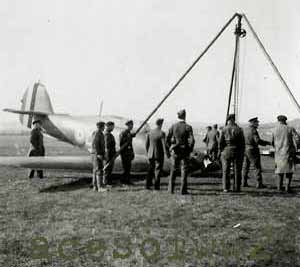|
_________________________________________________
HILLY'S BUTTON
Glenboro Man in R.A.F. Prizes Good Luck Token
With the Royal Air Force in France, 1 April 1940 - (CP) - The top button of his tunic is one of the prized possessions of a young Canadian fighter pilot from Glenboro, Man. It gets an extra polish before he goes on daily patrol on the western front.
|
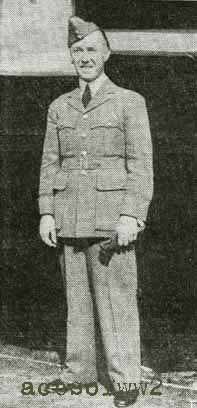 MARK HENRY BROWN |
His sister, Ruby, told the Free Press that Mark was always a lover of sports, especially flying, and could hardly wait after he received his pilot's license at Brandon to go to England. In three months he had passed his pilot officer's examination with honors and in 1938 was promoted to flying officer, she said.
Miss Brown admitted she was thrilled to hear of her brother's daring exploits and glad the button was bringing him good luck. "The English boys must have called him Hilly; we just call him Mark," she stated.
(In a letter home he wrote about this incident - "I will tell you about my latest excitement. On March 2nd I was leading two other chaps about the sky and we saw a Hun. I attacked, and had my prop shot away. I had to glide to a forced landing, but luckily I was high enough to get to an airodrome. I landed safely (at Nancy). One of the chaps was killed - he was our first casualty. They got the Hun. The next day the survivor of the bout and I were up again. We saw a Heinkel 111. We made no mistake this time and he came down with a bang. So I have two 50 per cent's, which makes a whole one. That is much better than the average have. Most of the boys haven't even seen one.
We had some foreign press correspondents here today. We gave them a bit of a flying display and talked to them for awhile. They were mostly Scandinavian and some Japs." - quoted from the book "Wings of the Morning" by Mark's sister Jean -jf)
_________________________________________________
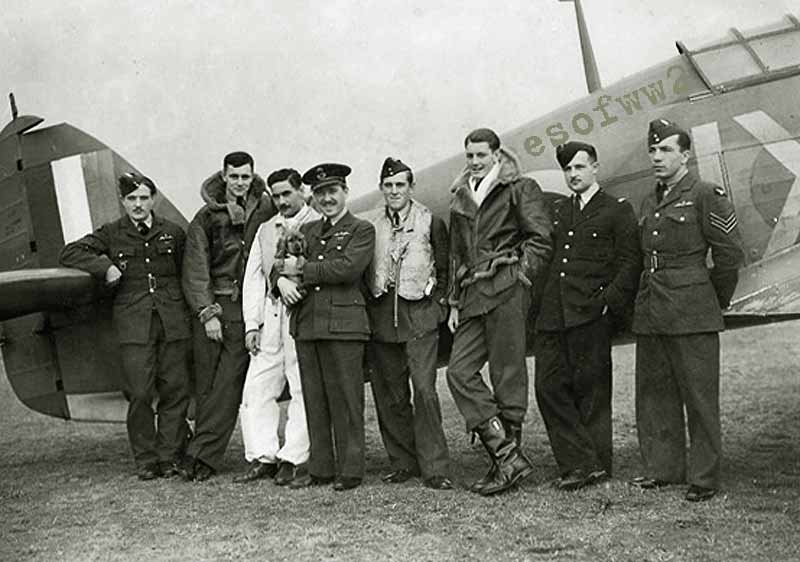 Some of No. 1 Squadron at Wittering in 1940. From L to R - Sgt. Anton Zavoral (Cz, KIA 31oct41), P/O Charlie Chetham (KIA 15apr41), P/O Arthur Clowes, F/L Hilly Brown (Can. KIA 12nov41), P/O Pat Hancock, P/O Tim Elkington, F/L "Moses Morlaix" DeMozay (Fr) & Sgt. Jan Stefan (Cz) - (Elkington collection) |
Glenboro Flier Is Promoted In the R.A.F.
May 1940 - First R.A.F. pilot to fly a captured Nazi plane, Mark Henry Brown, 29-year-old son of Mr. and Mrs. S. T. Brown, Glenboro, Man, has been promoted from flying officer to flight lieutenant. He returned to London on June 20, after being in France with No 1 Fighter squadron since early in September.
Writing to his brother, Roy C. Brown, at Portage la Prairie, he spoke of leaving France two days before France accepted Germany's armistice terms. "I left France on the last boat, having had a spot of airplane trouble in the north and just nicely catching the last transport in each case. None of my kit came out, so I found myself with only an old uniform," he said.
"It will be quite a while before I am as well equipped again. We have been lucky in not losing many men. The big loss has been in planes and equipment," he continued.
Flight-Lieutenant Brown, who has been recommended for the Croix de Guerre, was the first R.A.F. pilot to fly a Nazi plane. Early in May, he was selected to fly a captured Messerschmitt 109 fighter from France to the experimental station in England.
His squadron is reforming in England.
_________________________________________________
BROWN, F/L Mark Henry (37904) - Distinguished Flying Cross - No.1 Squadron
Awarded as per London Gazette 30 July 1940. Citation not published.
Public Records Office Air 2/6085 (Non-Immediate Awards, 1940-1941) has recommendation: "Since the beginning of the war Flight Lieutenant Brown has destroyed at least sixteen enemy aircraft. On 14th June, when leading his flight on patrol, he encountered nine enemy bombers, two of which were destroyed. Later he attacked nine Messerschmitt 109s, destroying one and driving the remainder off. As a result of bullets entering his aircraft he force landed near Caen, and was unable to rejoin the squadron before it withdrew from France. Flight Lieutenant Brown has shown courage of the highest order, and has led many flights with great success and determination when consistently outnumbered by enemy aircraft."
Air 2/8065 also has the formula for computing Advanced Air Striking Force awards for June 1940. The force had logged 2,775 hours; the operative divisor was 150. This gave a figure of 18 allowable awards, but as thirteen had already been granted (immediate awards), only five additional awards were deemed feasible. Nevertheless, authorities were advancing the names of 14 flying nominees (eleven DFCs and three DFMs) plus five periodic awards (one MC, one EGM and three MMs).
_________________________________________________
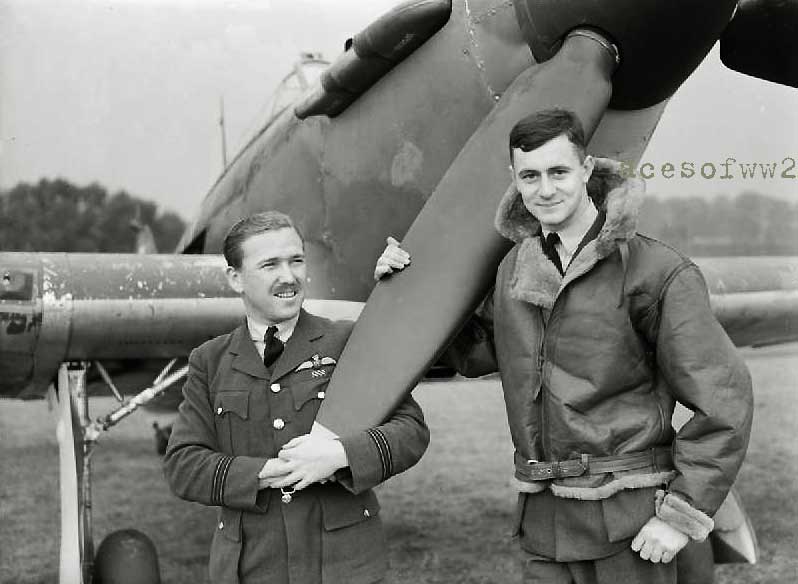
Wittering 1940 - Hilly Brown & Charlie Chetham, the shortest & tallest guys in the squadron - both were KIA (IWM)
_________________________________________________
BROWN, S/L Mark Henry (37904) - Bar to Distinguished Flying Cross - No.1 Sq.
Awarded as per London Gazette 23 May 1941
"This officer has commanded the squadron with outstanding success. He has destroyed a further two enemy aircraft bringing his total victories to at least 18. His splendid leadership and dauntless spirit have been largely instrumental in maintaining a high standard of efficiency throughout the squadron."
NOTE: Public Record Office Air 2/8752 has the original recommendation, prepared by the Officer Commanding, Station Kenley, on 18 April 1941: "This officer has commanded his squadron with outstanding success since November 1940. His dauntless spirit and outstanding qualities of leadership have maintained his squadron at a high standard of efficiency. He was awarded the Distinguished Flying Cross in August 1940 for his outstanding work in France where he destroyed at least 16 enemy aircraft. Since then he has accounted for at least two more enemy aircraft. During August 1940 he was shot down into the sea and suffered severe burns to his face, but in spite of this he resumed flying in ten days, having refused to take sick leave. Squadron Leader Brown has set an inspired example of devotion to duty and determination to destroy the enemy and I strongly recommend that on handing over command he should be awarded the Bar to the Distinguished Flying Cross in recognition of his distinguished services whilst serving with this squadron."
_________________________________________________
WAR ACE AT 28
Wing Commander Mark H. Brown, Glenboro, Has Brilliant Record
1941 - A Manitoba flier was a leading ace in that small band of fighter-pilots who fearlessly attacked literally thousands of Nazi planes during the Battle of France and the Battle of Britain. After being once shot down, with his plane in flames, he rose to become commanding officer of the famous No. 1 Fighter squadron of the Royal Air Force at the age of' 28. Odds 150 to Nine |
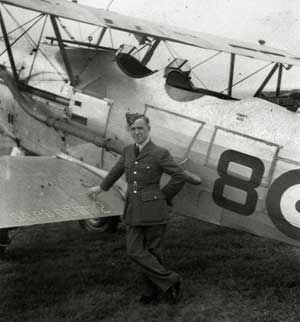 Hilly in his training days, stands with a Hart |
_________________________________________________
Glenboro Flier Reported Missing
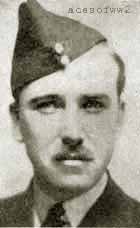 |
November 17, 1941 - Wing Commander Mark H. Brown, youngest son of Mr. and Mrs. S. T. Brown, of Glenboro, Man., has been reported missing after air operations, according to a cablegram received from the air ministry in London. Mark "Hilly" Brown has been reported missing |
_________________________________________________
MANITOBA ACE DIED FIGHTING
Word Dropped In Desert, Famed Glenboro Flier Is Killed In Action
LONDON, 15 Jan. 1942 [Canadian Press Cable] Canada has lost one of her most brilliant airmen of this war.
From the Mediterranean has come word that Wing Cmdr. Mark Henry Brown of Glenboro, Man., holder of the Distinguished Flying Cross and bar, who was credited with destruction of more than 20 Axis planes, had died in an air battle.
Wing Cmdr. Brown had been reported missing following air operations by the air ministry on Nov. 17 last.
A brief message which came fluttering down from an enemy plane over an isolated desert aerodrome reported that the 30-year-old ace had been "killed in a crash while fighting."
The note added that he had been buried with full military honors.
The plane which dropped the message was not identified but it was believed to be Italian. The Italians had been suffering a heavy toll at the hands of Brown's outfit, which they had come to fear and to respect.
"One Of Top Men"
But Brown had established a brilliant reputation long before going to the Middle East. In fighter circles he was known as one of the Royal Air Force's best. Once he was described by another Canadian, Wing Cmdr. J. A. Kent, as "one of the real top men in the whole outfit."
To those outside the Royal Air Force, Brown had all but lost his Canadian identity. In those days when it was forbidden to name personalities he gained anonymous distinction leading a fighter escort for bombers who had volunteered to destroy at all costs the Mastichy Bridge over the canal in Belgium in an effort to stem German progress in the early days of the Nazi attack in the west.
A versatile pilot as well as a fighter, Brown was reputed to be the first man to fly a German Messerschmitt 109 back to England for research inspection.
He'd fly any machine to attack any enemy, once plowing with another British fighter into 16 Junkers 87's which they drove back from a British target.
Easy going and good natured, he accepted his part in the war as strictly business. He had worked up from the rank of pilot officer to command of his squadron. He came to England in March, 1936, after obtaining his pilot’s license from the Brandon Flying club at Brandon. He was made a flying officer in 1938 and flight lieutenant in May, 1940.
To his men he was known as "Hilly," a contraction for his nickname, "Hildebrande." How he got that nickname none of his men could explain.
_________________________________________________
 Hilly's Flight, RAF Wittering - It's likely this and the other two photos from Wittering (somewhere above) were taken on the same day - some time in October 1940. From left to right - F/L Hilly Brown, Sgt Anton Zavoral, P/O Pat Hancock, Sgt Jan Stefan, P/O Arthur Clowes, Lt. Jean DeMozay, P/O Tim Elkington, P/O Charlie Chetham. Line 'em up, shortest to tallest, drop the camera in front of the shortest and voila; you'd never know the difference. Hilly, Willie & Ernie - proof you don't have to be big to be a badass! |
London Paper Lauds Manitoba Airman
London, 28 Jan. 1942 (CP Cable) — The Daily Express paid tribute today to Wing Cmdr. Mark H. Brown, Glenboro, Man., airman credited with downing a score of enemy planes, whose death in Libya was reported recently by Italian sources. The newspaper called him a great sweep leader and praised his courage and ingenuity.
Wing Commander Brown failed to return from an air operation in the Middle East and was officially listed missing, believed killed in action.
_________________________________________________
Ace Canadian Air Fighters Are Named by Winnipeg Flier
Winnipeg, March 2, 1942 - (CP) - Wing Commander J. A. (Alex) Kent of Winnipeg, member of a Royal Air Force squadron that shot down numerous Nazi planes during raids and over the Channel, said here today that Wing Commander Mark (Hilly) Brown of Glenboro, Man., killed in action, "was one of the best fighter pilots in the R.A.F. and still heads the list of Canadian aces" in this war.
Speaking before members of the Canadian Club, Wing Commander Kent told of how the Manitoban distinguished himself in several actions against the enemy as flight commander in the R.A.F.'s No. 1 Fighter Squadron.
Other Canadians whom he named as great fighters were members of No. 1 Canadian Fighter Squadron— Wing Commander E. A. McNab, Regina; Wing Commander Gordon McGregor and Squadron Leaders Dal Russel, Hartland Molson and Paul Pitcher, all from Eastern Canada.
He told how he and other British pilots drilled a squadron of Polish pilots. "One day the Polish squadron was practicing intercepting enemy raiders when they actually ran into a lot of Nazi planes. The fighters gathered around and got the trainees out of trouble except for one Polish airman (Lt. Ludwik Paszkiewicz -jf), who dashed across, shot down a Dornier 17 and then rejoined the squadron. The R.A.F. officers thought it was just lucky (According to post-war research, the plane misidentified as a Do 17 by Paszkiewicz was actually an Me110 -jf).
The next day however, the Poles shot down six Messerschmitts for no loss. Then the R.A.F. officers decided the Poles had trained enough and the squadron was allowed to go into action, which they did with a vengeance. Flying Hurricanes, the Poles shot down 130 enemy planes in the next six weeks," Wing Commander Kent said.
_________________________________________________
List Canadians in R.A.F. With Latest Casualties
Ottawa, May 25, 1942 (CP) — The Royal Canadian Air Force in its 273rd casualty list of the war today reported eight men missing after air operations overseas.
Six men previously reported missing overseas were listed now, for official purposes, as presumed dead.
Today’s casualty list contained a new section under the heading “Canadians in the Royal Air Force.” It contained the name of one man, previously reported missing overseas and now reported killed on active service. That man is:
Brown, Mark Henry, DFC & Bar, Wing Commander, previously missing, now presumed dead; S. T. Brown (father), Glenboro, Man.
_________________________________________________
BROWN, W/C Mark Henry (37904) - Czech Military Cross
Awarded as per London Gazette 12 January 1943
Public Record Office Air 2/6123 has correspondence relating to this award. Its genesis was in a letter dated 13 May 1941 from J. Sejnoha, Chief of Protocol, Czechoslovak Republic Chancellery, to Robert Dunbar of the Foreign Office. This expressed the Czech wish to bestow the award and provided a detailed citation: "This officer has up to the present shot down 17 enemy aircraft. As the leader of a British fighter wing, to which 11 Czechoslovak airmen have been attached, he has shown particular interest in, and effective understanding of, our Czechoslovak cause. He has displayed great devotion in directing the training of the Czechoslovak pilots and has personally led them into action, particularly in engagements in northern France in which they achieved exceptional success."
Internally the RAF grumbled that the Czech award appeared to be a duplicate of his Bar to DFC. At the same time, the Czechs had bestowed 22 awards on British personnel as opposed to six British awards to Czech personnel. Nevertheless, an official wrote, “While it is undesirable to increase the debt, it seems hardly possible to refuse the offer.” British approval was communicated to the Czechs on 3 June 1941. -HH
_________________________________________________

Little Towns of Canada Play Major Role in War
Glenboro, Man., Provides Good Example of What They Are Doing
(By Scott Young, Canadian Press Staff Writer)
With the R.C.A.F. Somewhere in England, 12 June 1943 —(CP)— The obscure towns and villages scattered across Canada are playing a part in this war that can be assessed best by choosing one of them and scanning its war record.
This happens to be the story of Glenboro, Manitoba, a prairie wheat town of about 500 population, because the two airmen who proposed this thesis are boyhood friends from Glenboro—Sgt. Howard Wilton and Flt.-Sgt. Turner Frederickson.
In peace-time, Glenboro is like a hundred, or 500, Canadian villages. Even the townspeople are close to the land, because the table-flat grain fields begin only two or three hundred yards from the main street. So they watch for rain for the crops, and their sons work in the harvest and curl, play baseball and visit sports meets at nearby towns.
Wilton and Frederickson are boys like that. Wilton's father runs a grain elevator in Glenboro, Frederickson's father a store. They shot and swam and loafed and worked in Glenboro in peace-time, but when war came, the village changed, and Wilton and Frederickson and every other man there changed with it.
Glenboro's Famous Flyer
Glenboro's first fame in war came through Wing-Cmdr. Mark Brown, D.F.C. and bar, whose score of enemy planes destroyed ran to more than 20 before he was killed in action in Africa early in 1942. Brown had been described by the careful English newspapers as a "great sweep leader," with the "courage of a devil and the aerial cunning of a monkey." Even the enemy thought of him so highly that when he was killed, an Italian plane dropped a note to say that he had died fighting and had been buried with full military honors.
Others have gone since Brown, among them Sgt. Ralph Thomson, an observer in the RCAF. Others came from Glenboro to take their places — Wilton and Frederickson, Sgt. Air Gunner Russ Wiggett, now a prisoner; F/O Rod (Junior) Hurton, son of Glenboro's dentist, who has been killed in action; Gordon Cline, in coastal command, now missing, the son of an elevator man, like Wilton.
The Boys Who Went Away
Wilton and Frederickson, trying to figure out just how many of their friends had left Glenboro to join Canada's armed services, knew they couldn't remember them all. So they concentrated just on the ones overseas, and when they were finished the list had reached more than 30 — and that just a minor percentage of the total in service from this prairie village of a few hundred people.
They remembered, of those in the army: Sgt. Lou Marsh, the Pennycook brothers, Cpl. Paul and Pvts. Jim and Andy; Dennis Westcott, Jim Legg, Burley Townsend, Mel Dowd, Helgi Oliver, Albert Oliver, Steve Einarson, Tom Wayte, Willie Campbell, Edwin Davidson, Douglas Dowd, Bill Mooren, John McKinnon, John Tree, Morley Doig, Louis and George Goodine, Blaine Wilson, Keith Natrass, Bert Budd, Arthur and Don Doig.
And when they finished naming all those fighting men from their village—the Goodines, the sons of a livery-stable hand; Einarsan, who was wounded at Dieppe, and Wayte and Campbell, who fought there with him; Helgi Oliver, who fought in the First Great War, too; Moore, who lost a leg in an accident over here — they thought they probably had forgotten some.
Perhaps they have, but they named enough. Glenboro is only one village, but you could change the names in the story and it would apply to any one of hundreds. That's the way the villages of Canada are fighting.
_________________________________________________
Beurling Ranks Fourth Among European Aces
By FRED BACKHOUSE, London, July 15, 1945 - (CP) - Group Captain J. E. (Johnny) Johnson, English-born, former leader of a crack Canadian Spitfire wing, has been officially recognized as "ace of aces" among Allied fighter pilots who fought over Europe.
Final scoring records, compiled by The Canadian Press from figures supplied by the RAF, RCAF, and United States 8th and 9th Air Forces, put this peace-time accountant from the Leicestershire town of Loughborough at the top of the list with 38 German planes destroyed.
G/C Johnson, who so closely identified himself with his otherwise all-Canadian squadron that he wore "Canada" on his shoulder, has often given much of the credit for his success to the Canadians who flew with him. "It's all a combination play," he said. Many of his men themselves became "aces."
Of the first 16 places supplied by the air forces, fourth is held by a Canadian — F/L George (Buzz) Beurling, DSO, DFC, DFM and Bar, of Verdun, Que. — and 11 by RAF pilots. For the record, only those with more than 24 "kills" were offered by the three services as their top men. Official final scores are:
G/C J. E. Johnson (RAF), 38
G/C A. G. Malan (RAF), 29.5
F/L G. Beurling (RCAF), 30
S/L B. Finucane (RAF), 29
W/C J. R. D. "Bob" Braham (RAF), 29
W/C C. Caldwell (RAF), 28½
W/C Stanford Tuck (RAF), 28
An anonymous Polish sergeant [Czech pilot Josef Frantisek -jf] (RAF), 28
Lt/Col F. S. Gabreski (U.S. 8th), 28
S/L J. H. Lacey (RAF), 28
Capt. Robert Johnson (U.S. 8th), 27
Maj. G. E. Preddy (U.S. 8th), 27
W/C F. R. Carey (RAF), 26
F/L E. S. Lock (RAF), 26
Lt/Col J. C. Meyer (U.S. 8th), 24½
F/L Mungo-Park (RAF), 12
[I have modified the arrangement & scores to be more accurate –jf]
RCAF fighter pilots in the European war with scores of 15 or more German planes destroyed number six according to overseas headquarters in London. In addition, there were two equally high-scoring Canadians in the RAF, both of whom were killed in that service before they could transfer to the RCAF. After Beurling they are:
SL H. W. McLeod, DSO, DFC and Bar, of Regina, 21
S/L V. C. Woodward, DFC and bar, 19
F/O W. L. McKnight, DFC and Bar, of Calgary, 16½
W/C Mark H. Brown, DFC and Bar, of Glenboro, Man., 16.45
W/C J. F. Edwards, DFC and bar, DFM, MiD, 16.1
W/C R. W. McNair, DSO, DFC and two bars, of North Battleford, 16
W/C E. F. J. Charles, DSO, DFC and Bar, Silver Star (U.S.), 15½
F/L Don C. Laubman, DFC and Bar, of Edmonton, 15
The late Wing-Cmdr. Brown is officially credited by the RAF with "at least 16" aircraft destroyed. His score may well have been higher, but uncertainty exists because the records of No. 1 Squadron, RAF, of which he was then commanding officer, were destroyed during the retreat at the time of the collapse of France.
_________________________________________________
Victories Include :
|
 |
16.95 - 16.45 / 1 / 2
| * Shared with S/L P.J.H. "Bull" Halahan ** Shared with, & according to, Rolly Dibnah [a] Becoming the First Canadian Ace of WW2 [b] No documentation [c] Surviving combat report suggests a probable |
_________________________________________________
back to --- Canadian Aces --- |
Check out |
_________________________________________________
See the book "Wings of the Morning" by Mark's sister Jean Segall (nee Brown)
See H. A. Halliday, "The Amazing 'Hilly' Brown" - Journal of the Canadian Aviation Historical Society, Summer 1971
_________________________________________________
Thanks go out to
Dave for the top photo & the one of the crash landing, courtesy of the Bob Niven collection.
& Grahame for sending me newspaper clippings and pix. His grandmother was a friend of Hilly's..
On these pages I use Hugh Halliday's extensive research which includes info from numerous sources; newspaper articles via the Canadian Museum of Civilization Corporation (CMCC); the Google News Archives; the London Gazette Archives and other sources both published and private.
|
Some content on this site is probably the property of acesofww2.com unless otherwise noted.
![]()


